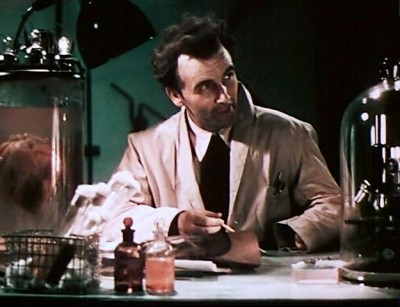
If you’ve ever wondered what I find to be the creepiest of all classic-era horror movies, then you probably have too much time on your hands. But at the same time, you’d probably like to know that it’s Doctor X (1932). As an exercise in atmosphere — with its odd color palette (thanks to the miracle of two-strip Technicolor in the last days of that process), strange sets and one of my favorite scenes in all of horror — director Michael Curtiz’s movie is hard to beat.
The film is structured as a mystery, with a cannibalistic serial killer nicknamed “The Moon Killer” on the loose, and all signs pointing to the murderer being a member of a medical school headed by Dr. Xavier (Lionel Atwill). In order to save the academy — and the set of creepy scientists who work there — any embarrassment, the doctor decides to perform his very own investigation via an unduly elaborate experiment to figure out which of his scientists is mad enough to go on a murder spree. Amongst all of this is a wise-cracking newspaper man (Lee Tracy) who’s out to get the real story behind “The Moon Killer.”
_thumb.jpg)
There’s a surprisingly grisly nature (for its time, at least) to the film, with dismemberment and mentions of necrophilia. But don’t think of Doctor X as stomach churning, since the tone is agreeably absurd. Tracy and the film’s flock of possibly mad scientists lend a sense of levity to it all. None of this is to be taken too seriously, of course, but when the film gets down to business and decides to be scary, it earns its reputation.There’s a strangeness to the way Curtiz handles Doctor X’s horror elements. There’s a certain grotesqueness on display, mostly due to the rudimentary color stock — something that goes full tilt in the big reveal of “The Moon Killer.” Here we get a scene that’s not only horrific (the creature himself is a bizarre, willfully ugly creation) but it’s his transformation — which is handled in an almost surreal nature — that almost single-handedly makes the movie worth it. Part of what makes Doctor X unique is that no one’s ever made a movie quite like it since.




As much as I was surprised that Justin chose The Testament of Dr. Mabuse, I was even more surprised by this choice. I didn’t get that strong of a sense of him being so taken with Doctor X when we ran it late night at a certain theater where we used to work. (I knew the strength of his response to, say, Sunrise and Twentieth Century, but not this.) I guess this comes from the fact that we don’t always talk enough about these things — and the fact that he’s not prone to gush,
the fact that he’s not prone to gush
You’re obviously not following him on Twitter.
Well, that’s certainly true. I don’t twat and I don’t have anything to do with Twatter.
Ken ~
Watched this film earlier and agree with the 5* rating.
Most significant to me – meticulously woven into something
that struck me in awe as much as when I first truly watched
Bela Lugosi’s Dracula with the Philip Glass score.
I’d like to watch this again with some ambient sound-scape
music playing along side … in the background. Perhaps add
a bit of more eerie to it !
Ms. Wray was sure a knock-out for sure.
I should note that this is Justin’s five stars, not mine — though I gave the film five stars myself about two years ago.
http://www.mountainx.com/movies/review/doctor_x_mark_of_the_vampire
If you read that earlier assessment, you’ll find that I am of the opinion that the lack of a musical score is part of what gives the film its creepy quality. Actually, I feel the same way about Dracula, so I’m not as enthusiastic about the idea of adding music as you are.